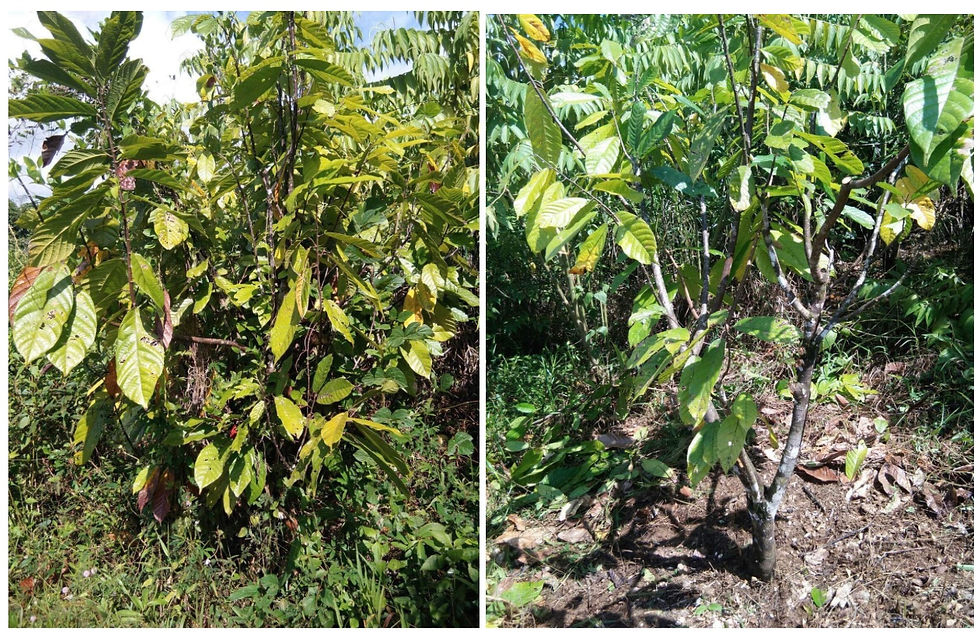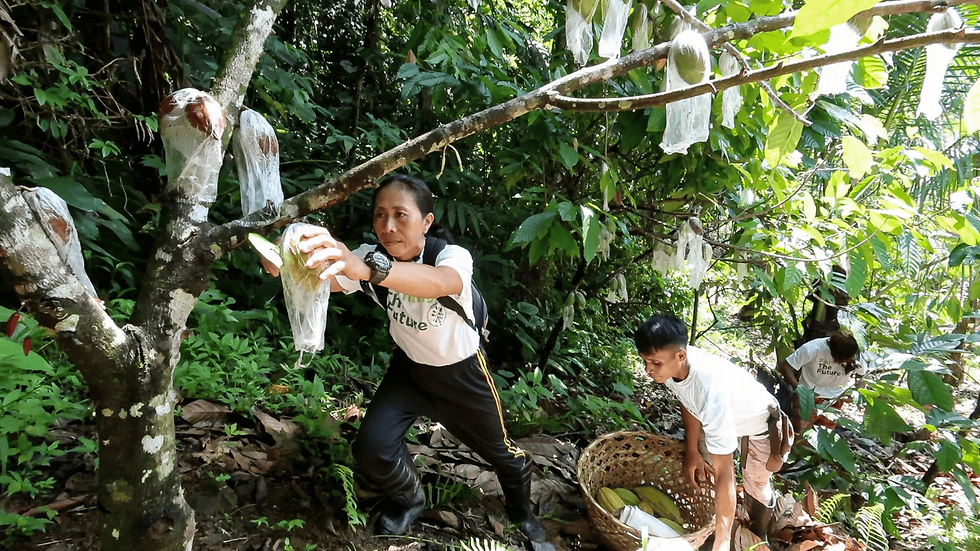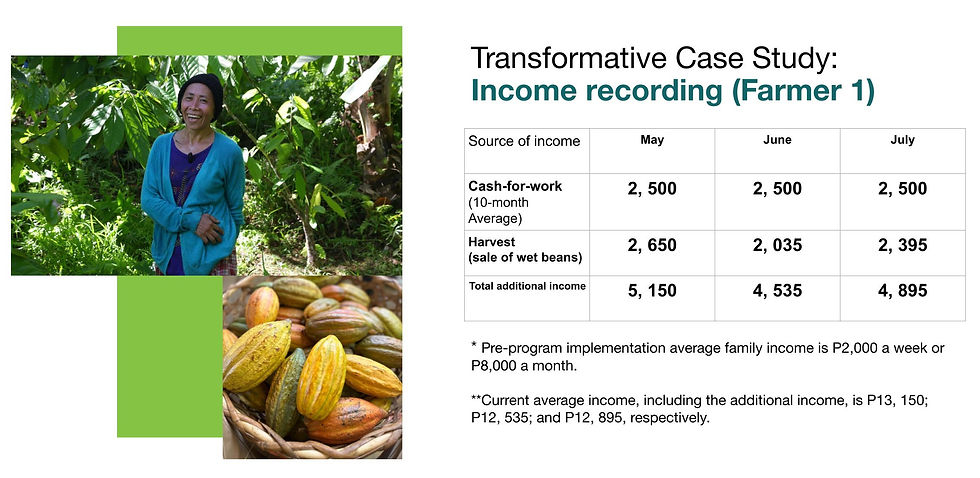The information shared by the Philippine Department of Trade and Industry-Region 9, the Department of Agrarian Reform (DAR), and the Department of Environment and Natural Resources (DENR), along with findings from PhilSEED's on-ground assessment, reveals that six barangays in Zamboanga Sibugay—Guinoman (Diplahan), Upper Sumilong and Nanan (Payao), Don Perfecto (RT Lim), Tipan (Naga), and Culasian (Titay)—collectively have approximately 500 to 700 hectares of cacao farms. Most of these cacao trees were planted through the National Greening Program (NGP) of the DENR and partnerships involving DAR, Land Bank, and a commercial agricultural company over the past five years. Unfortunately, many of these farms have been abandoned, rendering them unproductive.
Globally, the cacao and chocolate market was valued at USD 143.43 billion in 2023 and is projected to grow to approximately USD 225.05 billion by 2032[1]. In March 2024, cacao prices reached a record USD 10,000 per metric tonne due to a supply-demand gap[2]. According to the International Cocoa Organization (ICO) estimates a production deficit of 462,000 tonnes, representing about 10% of the 4.3 million tonnes global demand for cacao in the 2023/2024 crop year[3]. Locally, the Philippines’ cacao production was only 9,341 tonnes in 2020, far below the annual target of 100,000 tonnes of dried beans set for 2022[4].
Despite the high demand for cacao, farmers struggle to profit. The primary challenges include a lack of financial resources and inadequate knowledge of proper cultivation practices. With average earnings of just Php1,500 weekly or Php6,000 monthly, these farmers live below the poverty line and face food insecurity[5].
Spotting both a problem and an opportunity, PhilSEED initiated a pilot intervention to provide capital and capacity-building support to rehabilitate the cacao farms within eighteen months. This aims to help them generate income and lift themselves out of poverty, in the economic forecast, within 3 to 5 years.
The Pilot Intervention

Despite the challenges facing cacao farmers in Zamboanga Sibugay, PhilSEED identified an opportunity to address poverty in the province. In July 2023, PhilSEED launched a pilot implementation of its Cacao Farm Rehabilitation Program in Guinoman, Diplahan, Zamboanga Sibugay, benefiting 15 farming families. This pilot program received co-funding from the Australian NGO Balangay Limited, contributing Php1,000,000, and the Assisi Development Foundation, providing Php500,000. Additional support was extended by the Department of Trade and Industry (DTI) Region 9, the Provincial Agriculture Office (PAO) of Zamboanga Sibugay, and cacao bean buyer Dalareich Chocolate House. Balangay Limited also serves as a co-implementer of the project, offering technical assistance on regenerative agriculture practices.
The primary objective of the pilot program is to evaluate the feasibility of cacao farm rehabilitation as an effective poverty alleviation model. With a philanthropic investment of ₱83,228 per one hectare, over eighteen months, the program provides comprehensive support covering labor, fertilizers, farm equipment, and operational and management assistance.
Initially, farmers displayed individualistic tendencies, but joint farm activities helped cultivate a strong sense of cooperation and mutual care. This collaborative spirit led to the establishment of the Guinoman Cacao Farmers Association (GCFA), an informal organization that fostered community spirit and teamwork among local farmers. Training sessions addressed critical knowledge gaps, reigniting the farmers’ enthusiasm for cacao farming and equipping them with vital skills. Moreover, the program's technical and financial support significantly improved the health of their cacao trees, enhancing productivity.



Case Study
Prior to the program's implementation, the average income of participating farming families was approximately P1,500 per week or P6,000 per month, placing them below the national poverty threshold set by the Philippine Statistics Authority (PSA).

Following the introduction of the cacao rehabilitation program, Farmer 1 (F1) experienced a significant increase in combined income, earning P13,150, P12,535, and P12,895 during the peak harvest months of May to July, nine months after the program began. Notably, these earnings place F1 above the PSA poverty threshold during this period. It is projected that this trend will repeat during the next harvest season from November to January, indicating that F1 could potentially rise above the poverty threshold for half of the year.
Additionally, the adoption of regenerative agricultural practices has enabled farmers to continue harvesting during off-peak months. For instance, F1 reported regular bi-weekly harvests from August to October, earning an average of P1,423 per month during this period from the sale of beans. These results are based on a one-hectare cacao farm with approximately 800 trees and a 10% fruiting rate during data collection.
Aside from the sale of beans, which were purchased at P100 per kilogram for wet beans, a standout feature of the program was the Cash-for-Work (CFW) initiative, which created employment opportunities in the community. Farmers highlighted the necessity of CFW, sharing that without it, they will be forced to work on other farms to earn a living, leaving little time to rehabilitate their own cacao farms. This insight shifted the perception of sweat equity, emphasizing that for the poorest farmers, CFW is a crucial support mechanism. It allows them to meet basic needs while rebuilding their livelihoods through farming.
Based on the data and insights gathered at this stage of the project, several promising assumptions can be made. First, the rehabilitation of abandoned and unproductive cacao farms in Zamboanga Sibugay, estimated at 1,350 hectares according to agency reports, presents a viable and scalable model for poverty alleviation. By restoring these farms, farmers gain a stable source of income while revitalizing local agricultural activity. Second, cacao farmers possess untapped earning potential through farm expansion, as most program participants have an additional 2–3 hectares of land available for cultivation. Scaling up farm activities could lead to a substantial increase in income. Finally, optimizing yields through better farming practices and improved harvest quality is critical. Current income levels are derived from suboptimal outputs below industry standards, demonstrating the significant potential for productivity and profitability once farms are fully rehabilitated.
While F1 represents just one of the farmers involved in the program, the overall results among other participants, though varied, consistently show significant potential for increased household income. A comprehensive analysis of these outcomes will be included in the final case study report for Brgy. Guinoman, the pilot community, scheduled for release in March 2025. This report will examine the economics of cacao farm rehabilitation, the rehabilitation process itself, and the operational and management capacities necessary for successful implementation. It will also address the challenges encountered and the lessons learned, which will be critical in scaling up and adopting the initiative. By providing these insights, the report aims to demonstrate the initiative’s potential as a scalable poverty alleviation model, specifically tailored to the context of cacao farmers in Zamboanga Sibugay.
The program has now been expanded to five additional barangays in the province. In the next article, we will delve into the journey of these communities, examining their progress and validating the observations and insights generated from the pilot community.
References:
[2] https://www.cnbc.com/2024/03/26/cocoa-prices-hit-10000-per-metric-ton-for-the-first-time-ever.html
This article is part 2/3 of a series on Poverty Alleviation, written by Josh Mahinay, a social entrepreneur involved in various enterprises and social impact initiatives in the Philippines. His interest in business for social good inspired him to pursue entrepreneurial and social innovation studies at the Asian Institute of Management (AIM) in Manila and at the London School of Economics and Political Science (LSE) in London.





Comments